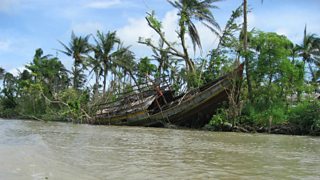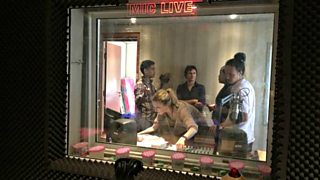Myanmar: seeing emergency information in a new light
Becky Palmstrom
Radio Trainer/Producer, BBC Media Action Myanmar
Tagged with:

Men building a raft after August 2015's flooding in Myanmar
In the light of recent floods in Myanmar, also known as Burma, Becky Palmstrom reflects on how the country has strengthened its preparations and response to natural disasters since 2008’s Cyclone Nargis.
Back in 2008, Cyclone Nargis struck the Myanmar coast late one afternoon tearing across the low lying Ayeryarwaddy delta with winds of 215 kilometres an hour.
Later, as the winds and rains reached Yangon, also known as Rangoon, our house was plunged into darkness. When the sounds of breaking glass and screeching winds became too ominous, I retreated beneath my bed. Many people lost their roofs around midnight and then sat out the storm in stairwells or among the debris of their roofless homes.
Meanwhile, it was worse in the delta. Much worse. A combination of hurricane force winds and a storm surge, reaching almost four metres killed almost a hundred and forty thousand people.
Limited warning
In the days preceding the storm, India’s Meteorological Department had warned the Myanmar government that if the cyclone reached the shore, it was going to be bad but the government and media issued very limited information. The New Light of Myanmar newspaper published a short article on its back page asking people to be prepared for rainstorms: wind speeds over 50 kilometres an hour, it said. State radio and TV followed suit. There was little information about how people could prepare and no evacuation or warnings about the possibility of a tidal surge.

A boat destroyed in Myanmar by Cyclone Nargis, 2008.
When the storm exhausted itself I visited the devastated delta region. Every public building was battered and packed with suvivors from nearby villages: a woman from a village that had lost all its children, a man scarred from holding onto a mangrove tree all night. One man was forced to abandon his six-year-old son when he could no longer swim with the boy grasping round his neck.
Lifeline radio
We searched for practical information on local radio but little came. The BBC Burmese service with support from BBC Media Action began broadcasting its ‘Lifeline’ radio show a month after Nargis hit. “Kyanmarye ne Naung ye” (Living Today, Stronger Tomorrow) continued for nine months.
Since that time, so much has changed. The government has made political reforms, formal censorship of the media is over, more humanitarian and development organisations have access to work here, and vitally, the government is now better prepared to respond.
What has not changed is Myanmar’s risk of cyclones and storms.
A shift in emergency communication
We’ve continued to work with key government, media and humanitarian organisations to improve the way they cooperate to get practical information to people affected. Together, we’ve prepared a series of messages prioritised for 24 hours and 7 days after a disaster - covering topics such as health and safety, keeping family members together and advice on minimising stress and anxiety. The messages, specifically for people hit by either an earthquake or a cyclone were tested in advance across the country to make sure they were easy to understand.

Our team in Myanmar working to produce a Lifeline radio show for people affected by the 2015 floods.
Linking Hands to Keep Living
Last week, when the government declared a state of emergency in places hit by some of the worst flooding Myanmar has seen for years, we began sharing prepared messages, reminding media organisations that they could broadcast them too. Within 48 hours, BBC Media Action began working with Myanma Radio’s journalists to produce a twice daily radio show for people. The Lifeline radio programme, called Shin Than Chin Kan Lan Mya (Linking Hands to Keep Living) follows the weather report on every news broadcast. Before the floods 8.2 million people in the affected areas listened to Myanma Radio.
We’ve used the broadcasts to answer questions about whether a local berry is enough to purify water (it isn’t), and how to prepare for evacuation (stick together, ensure children know their village and parents’ names, and bring identification, water and food). The programme is also translated into other languages for non-Burmese speakers.
I still have the New Light of Myanmar news clipping from 2008. It now serves as a reminder of how far Myanmar has come since that difficult time.
Related links
Read more on our work in Myanmar
Follow us on Facebook and Twitter
